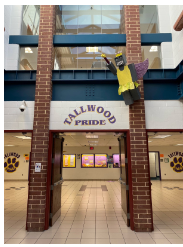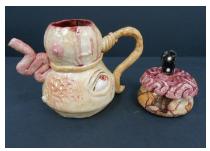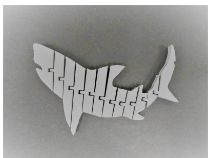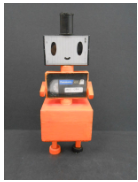The course is designed for students interested in developing more sophisticated skills in working with three-dimensional media. The uses of drawing, painting, and digital design, especially as they apply to three-dimensional art forms, are examined. The standards and objectives are organized into five specific content strands: Creative Process; Critical Thinking and Communication; History, Culture, and Citizenship; Innovation in the Arts; and Technique and Application. In addition to work in class, students develop a portfolio of artwork and participate in various art shows. Students develop visual literacy and appreciation for art through written, visual, and verbal expression. Students will also explore career options, public art, and copyright fundamentals in the field of art and are expected to participate in various
art shows.
Essential Questions: What Are the Big Issues About Art? How and Why Do We Make Art? How Does Art Relate to History and Culture? How Do We Respond to Works of Art?
|
Unit Title and Quarter |
QUARTER 1 |
QUARTER 2 |
QUARTER 3 |
QUARTER 4 |
||
|
Visual Spaces |
Connections |
Community |
Innovation and Imagination |
|||
|
Image Cue |
 |
 |

|

|
||
|
Focus of the Story |
We begin by starting our journey by discussing how people make art and use visual tools in their visual spaces. We look to this as a foundation of the purpose of our journey in the art classroom and exploring 3D approaches in artmaking. |
Once we understand the beginning steps, we can start to shift our focus on how art reflects our individual and shared identities. We can look at personal connections of community and cultural backgrounds to build the foundation and share our stories. |
Now, we can move into investigating the various ways artists explore and connect with their community. We can look at personal and cultural connections to build the foundation and share our relationships. |
Finally, we can explore how art allows us to be innovative with our ideas and approaches. We can reflect on our background and share our stories with others to build upon ideas and grow as an art community. |
||
|
Transfer Goals |
The Creative Process Apply creative process through inquiry, investigation, generating ideas, testing solutions, refining, and reflecting on process and product while developing a personalized portfolio exhibiting original voice and vision as an artist. Critical Thinking & Communication Understands and develops an appreciation that art can have diverse values, meanings, and definitions while recognizing multiple responses and perspectives. Effective at receiving and articulating ideas using appropriate vocabulary and communication when responding to works of art. Able to work independently and collaboratively. |
Critical Thinking & Communication Understands and develops an appreciation that art can have diverse values, meanings, and definitions while recognizing multiple responses and perspectives. Effective at receiving and articulating ideas using appropriate vocabulary and communication when responding to works of art. Able to work independently and collaboratively. History/Culture/Citizenship: Explore and understand historical influences of art through the work of self and others while cultivating an awareness that art is a reflection of time, place and culture. Students identify and interact with art as a community member and citizen, developing a lifelong engagement with artas a supporter, advocate, |
History/Culture/Citizenship: Explore and understand historical influences of art through the work of self and others while cultivating an awareness that art is a reflection of time, place and culture. Students identify and interact with art as a community member and citizen, developing a lifelong engagement with art as a supporter, advocate, creator, and informed viewer. Techniques & Application Able to transfer and apply knowledge of artistic skills and techniques when developing ideas for creative expression through a variety of media. |
Techniques & Application Able to transfer and apply knowledge of artistic skills and techniques when developing ideas for creative expression through a variety of media. Innovation in the Arts Understands and applies the artistic process, problem-solving skills, current and emerging technologies while making connections to visual arts careers. |
||
|
Learning Targets |
As an artist, I can: Generate ideas for works of art through exploration and inquiry and select materials, media, and processes of personal interest Communicate a personal style and point of view in artwork. Communicate well-supported and persuasive interpretations of sculpture, ceramics, and craft objects using appropriate terminology Identify common characteristics of works of art and design that are presented as a series or sequence, Describe, analyze, interpret, and evaluate personal, peer, and professional works of art and design and expand on constructive approaches to critique such as in-progress (formative), self-reflective, and summative. |
As an artist, I can: Examine definitions of art using aesthetic theories to discuss differences in perspective such as Formalism, Emotionalism, Immitationalism, Instrumentationalism, Explain the difference between informed judgments and personal preference when discussing works of art and design Explore the relevant value and function of various 3D art forms. Explain the difference between an original idea that draws inspiration from other sources and copying works Unethically Demonstrate appropriate use of planning and resources to create original works of art. |
As an artist I can: Identify ways that 3D art can be used to address community needs. Demonstrate proficiency, skill, and control in the use of 3D media and techniques. Combine traditional and nontraditional 3D media to create works of art. Interpret a subject and apply knowledge of 3D art/design history to the development of their personal style. |
As an artist, I can: Employ elements of art and principles of design to effectively communicate intended meaning in 3D works of art and design. Use a variety of techniques such as positive and negative space, mass, scale and volume to create occupied and unoccupied space in works of art. Expand on observational skills to create expressive and meaningful 3D designs that are inspired by various sources. Identify how digital media, and technology tools can be used to create, edit, and present works of 3-D art |
||
